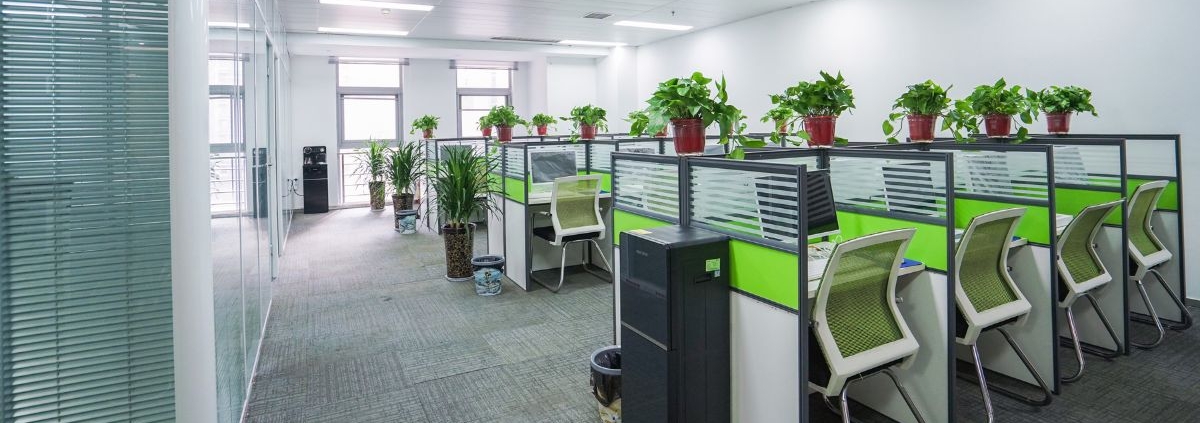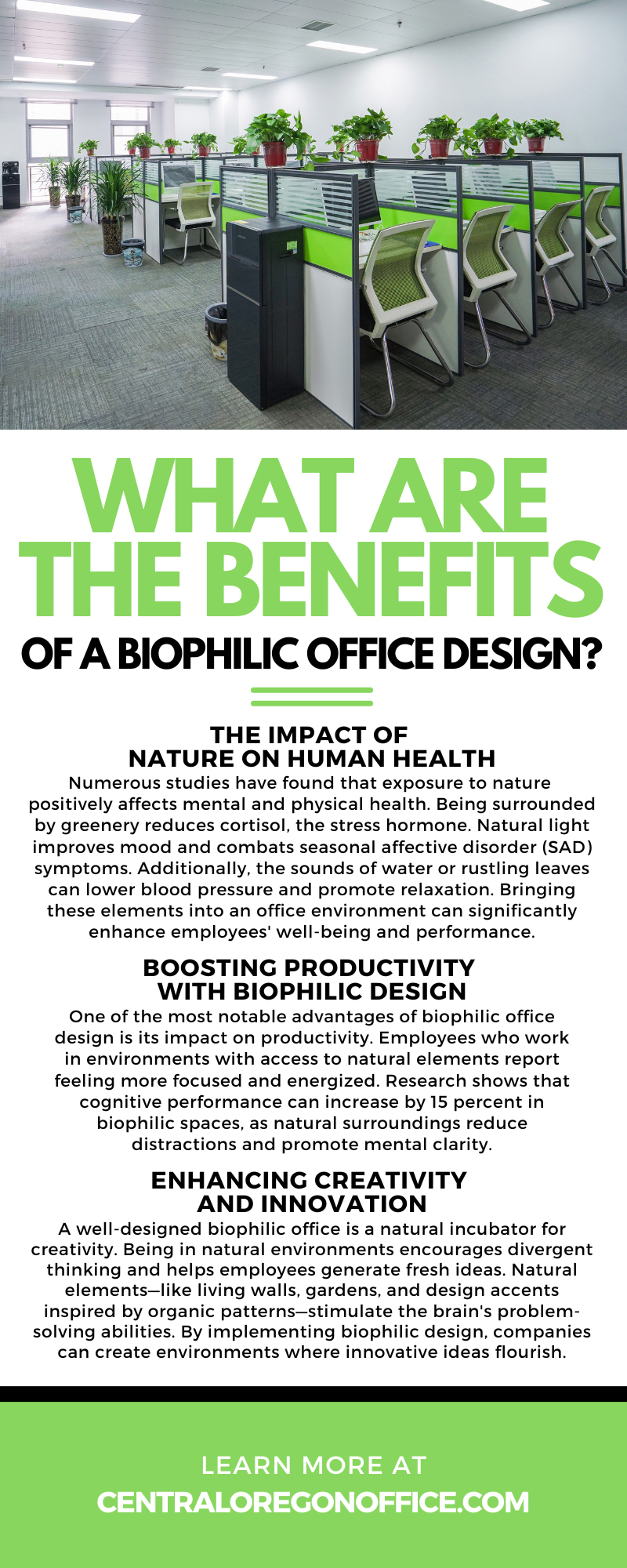What Are the Benefits of a Biophilic Office Design?
Office space design has evolved dramatically over the years. Designers are replacing traditional cubicles and sterile environments with layouts that prioritize comfort, creativity, and well-being. Among the growing trends in workspace design is biophilic design—a concept incorporating natural elements into the built environment.
This approach aesthetically transforms workplaces and provides measurable benefits for employees and businesses. Let’s explore the benefits of biophilic office design and why it may be the right choice for your workspace.
What Is Biophilic Design?
Biophilic design highlights our innate connection to nature and its impact on our health. It integrates natural elements—such as plants, natural light, water features, and organic materials—into the built environment to create healthier, more enjoyable spaces. The goal is to balance human-made spaces and the natural world, ultimately enhancing productivity, well-being, and engagement.
Is Biophilic Design Right for Your Office?
Before implementing biophilic design, consider the specific needs of your organization:
- Are your employees stressed or disengaged? Natural elements will calm and refocus them.
- Is your workplace designed for creativity and collaboration? Biophilic spaces inspire innovation and teamwork.
- How do you want your company to be perceived? A biophilic office communicates a commitment to well-being and sustainability.
The Impact of Nature on Human Health
Numerous studies have found that exposure to nature positively affects mental and physical health. Being surrounded by greenery reduces cortisol, the stress hormone. Natural light improves mood and combats seasonal affective disorder (SAD) symptoms. Additionally, the sounds of water or rustling leaves can lower blood pressure and promote relaxation. Bringing these elements into an office environment can significantly enhance employees’ well-being and performance.
Boosting Productivity With Biophilic Design
One of the most notable advantages of biophilic office design is its impact on productivity. Employees who work in environments with access to natural elements report feeling more focused and energized. Research shows that cognitive performance can increase by 15 percent in biophilic spaces, as natural surroundings reduce distractions and promote mental clarity.
Real-World Inspiration: Amazon’s Spheres
The Spheres at Amazon’s headquarters in Seattle exemplify biophilic office design at its best. These glass-domed structures house over 40,000 plants from across the globe, creating a rainforest-inspired environment complete with treehouses and meeting spaces surrounded by lush greenery. Employees use the space for breaks and inspiration, often reporting feelings of rejuvenation and motivation due to the natural atmosphere.
Enhancing Creativity and Innovation
A well-designed biophilic office is a natural incubator for creativity. Being in natural environments encourages divergent thinking and helps employees generate fresh ideas. Natural elements—like living walls, gardens, and design accents inspired by organic patterns—stimulate the brain’s problem-solving abilities. By implementing biophilic design, companies can create environments where innovative ideas flourish.
Improving Employee Well-Being
Employee well-being is a critical consideration for modern business leaders. Biophilic design has been shown to improve mental and physical health, leading to higher employee satisfaction and lower turnover rates. Features like improved air quality, access to daylight, and calming natural sounds help create a workplace where employees genuinely enjoy spending time, fostering loyalty and engagement.
Reducing Stress and Burnout
Stress and burnout are prevalent issues in today’s fast-paced corporate world. Biophilic design can mitigate these challenges. Natural elements in the office, such as indoor plants or scenic views, have calming effects that can reduce stress levels significantly. Incorporating areas for relaxation, such as breakout rooms adorned with greenery or serene water features, enables employees to recharge and refocus during their workday.
Creating a Stronger Connection Between People and Place
Employees who feel connected to their workspace are more likely to stay engaged and motivated. Biophilic design enhances this connection by creating an environment that feels comfortable, inspiring, and aligned with human nature. The warmth of natural wood finishes, the vibrancy of plants, and the presence of natural light make the workplace feel less like a sterile office and more like a nurturing space.
Enhancing Air Quality and Sustainability
Plants play a dual role in biophilic office design—they enhance aesthetics and improve air quality. Greenery acts as a natural air filter, reducing the concentration of toxins and improving indoor air quality. Additionally, many biophilic elements, such as energy-efficient windows and eco-friendly materials, contribute to sustainability efforts, allowing companies to reduce their environmental footprint.
Increasing Employee Satisfaction and Retention
Happy employees are loyal employees. Employees appreciate workplaces that prioritize their health, comfort, and overall experience. The positive atmosphere created by biophilic design translates into a sense of belonging and pride, making employees less likely to leave.
Encouraging Collaboration
Biophilic design often involves creating open spaces, shared tables, and inviting environments that encourage collaboration. Inspired by nature’s ability to bring people together—as seen in public parks or natural gathering spots—this design approach fosters conversation, teamwork, and innovation within teams.
Attracting Top Talent
Workspaces involve more than just desks and chairs; they reflect a company’s culture and values. Biophilic office design offers powerful benefits that can attract top talent in a competitive job market. A workspace that supports well-being and a connection to nature signals a company’s commitment to employee satisfaction and long-term success.
Prospective employees value companies that demonstrate forward-thinking and care for their teams’ well-being. A beautifully designed office can become a company’s unique selling point during hiring.
How To Implement Biophilic Design
Now that you understand the impact of biophilic design, you might be eager to transform your office environment. Here are a few actionable ways to bring nature into your workspace and boost productivity, creativity, and well-being.
- Add plants: Start small with potted plants and scale to living walls or indoor gardens.
- Maximize natural light: Replace heavy blinds with transparent shades or rearrange workstations closer to windows.
- Use natural materials: Incorporate wood, stone, and other organic textures in furniture and decor.
- Introduce water features: Create a sense of calm with water fountains or small ponds.
- Leverage color psychology: Use earthy tones like greens and browns to mimic nature and promote relaxation.
Personalized Design
Biophilic office design is a powerful, research-backed approach to boosting productivity, enhancing creativity, and supporting well-being in the workplace. Businesses can create spaces that employees love and thrive in by striking a harmonious balance between urban structures and natural elements.
Is your current workspace lacking that inspiring spark? Consider exploring how biophilic design can transform not just your office but also the way your team works. For tailored strategies, contact design experts who specialize in creating biophilic office environments. It’s time to evolve your office into a space where work feels like fresh air.
Partner with the expert office design consultants at Rose City Office Furnishings to bring nature-inspired innovation into your workspace. Let us help you create an environment that enhances well-being, creativity, and productivity.




